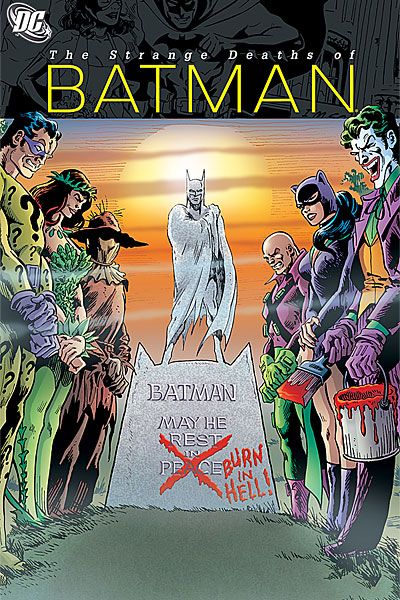Some might call a collection like "Batman: The Strange Deaths of Batman" a "cash-grab" or a "cynical attempt to make money off Batman's 'death' in 'Final Crisis.'" But it really does make sense to provide some context for the current death of Batman, and a trade paperback reprinting some of Batman's greatest "deaths" seems like a good idea. It's a fun way to trace the development of storytelling styles over the decades, all handily tied together under one thematic umbrella.
Unfortunately, this collection is wildly uneven, and at $19.99, I don't see enough quality here to fully justify that price. Some of the stories are good -- one, in particular, is a work of deranged genius -- but the rest are bottom-of-the-barrel darknight detective episodes, with the most recent stories tending to be the worst.
"Batman: The Strange Deaths of Batman" is certainly interesting as a kind of time-lapse photography experiment on the different incarnations of Batman over the years. You can feel the post-Frank Miller influence on the last two stories in this volume, with John Stanisci's 1997 installment, "The Prison," a particularly leaden pastiche of the hard-boiled, first-person narration Miller popularized in the 1980s. Stanisci's tale spotlights Talia, and it deals with the psychosexual relationship between Ra's al Ghul's lethal daughter and the Batman, but the approach to the narrative is so heavy-handed, the storytelling so bleak, that it shows how superficial that era of Batman stories really is, especially after the imaginative stories which precede it in this book. By the 1990s, Batman has lost his personality -- had lost what made him Batman -- and become a tank rolling across the fields of vengeance. He was little more than the Punisher with big ears and less guns. At least, you'd be hard-pressed to prove differently if Stanisci's story is any representative sample of that era of Batman tales.
And Chuck Dixon's miniature Catwoman dream-sequence which concludes this book is an absolutely forgettable little beast that's notable only for the surface indications of Greg Land's stylistic shift. Within the span of six pages, you can see his early Adam Hughes/Stuart Immonen style morph into the pornstar Photoshop technique he uses today. It's his career in a nutshell, and the change is evident in these pages.
But it's not all bad, as the first two stories -- by Gardner Fox and Cary Bates, respectively -- provide some wonky Silver Age fun (and two great images of Robin with tears streaming down his domino mask). And David V. Reed's four-issue death of Batman epic from 1977 offers some wonderful twists and turns as the villains put each other on trial to figure out who really killed the caped crusader. Each issue spotlights another attempt to take credit for Batman's death, and the trial itself is fun to witness from a safe, readerly perspective.
The highlight of this book, without a doubt, is Bob Haney and Jim Aparo's Batman/Atom team up from 1974. In this ridiculously great tale, a brain-dead Batman is reanimated by a microscopic Atom, who literally jumps around on top of Batman's brain, triggering actions like walking and punching. It's like the Atom is a mecha pilot, only instead of steering a giant robot, he's steering the flesh and bones form of Batman, helping to rescue a young girl from the clutches of the mob. The "science" used to justify the Atom's reanimation technique is completely absurd, and just when you think the story is as silly as it can get, it gets even sillier, but it's full of imagination and images that you've never seen in a Batman comic before.
The Haney/Aparo story may be enough to make this book worth a look, but you can surely find that story reprinted elsewhere, or buy the original issue for less than the cost of this rather expensive collected edition.

